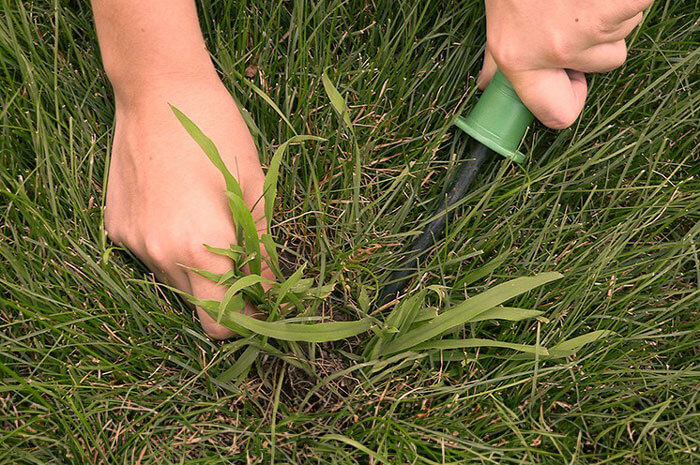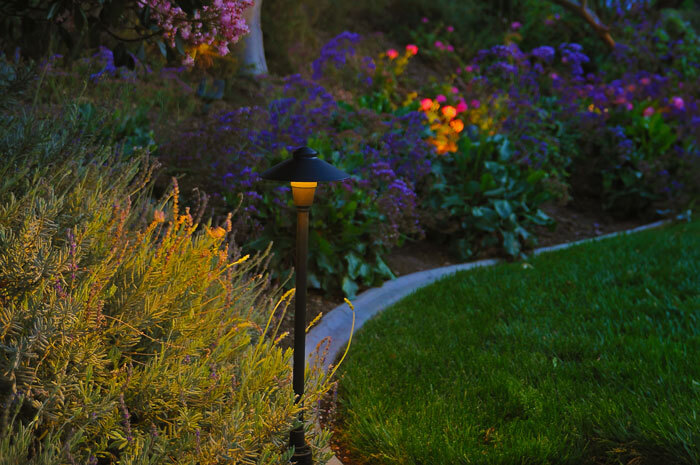
If you’re wondering what those plants are growing in your grass and what to do about them, you’re in the right place. Here, we’ll cover some of the most common weeds in lawns and how to eliminate them.
Annual Bluegrass (Poa annua)
Annual bluegrass is one of the most common types of grass weeds. This light green, low-lying annual prefers compacted, infertile soils. The grassy weed grows best in the cool-season but can be found throughout the seasons.
If your lawn suffers from a sudden brown-out in the heat of summer or abundant seed production in the spring, you’ll know that you’re dealing with annual bluegrass. When seed production occurs, you can prevent further spreading by raking the grass upright before mowing the grass and bagging the clippings.
Crabgrass (Digitaria species)
Few summer lawns are without this warm-season annual that branches out its low-growing, wide leaves. There are two varieties: hairy crabgrass, which is more upright and large, and prostrate crabgrass, which is smoother and smaller. Prostrate crabgrass stands out with purple-toned stems.
You might notice abundant seed heads that stand out like long fingers on both types of crabgrass. To control crabgrass it is essential to mow high, remove seed heads, and maintain dense turf.
Purslane (Portulaca oleracea)
Out of all the common lawn weeds, you’ll find that purslane is one of the easiest to pull by hand. This creeping succulent is also called garden purslane and hogweed. It can be identified by its smooth reddish stems and fleshy leaves. They may also bear yellow flowers that leave behind black capsules filled with black seeds. Likely a native to the Middle East and Northern Africa and now found throughout the United States, this annual prefers hot, dry weather.
While weeding the plants by hand may be easy due to their shallow root system, be sure and retrieve all stem fragments. As this weed is a succulent, any fragment may put down roots.
Prostrate spurge (Euphorbia prostrate)
Thriving in the heat of summer, this low-lying annual can be detected by its circular growing pattern and its hairy stems studded with green leaves. When broken, the stems leak a milky sap that can irritate the skin. If the spurge in your lawn has a purple leaf spot, it’s a related variety called spotted spurge.
Whether spotted or prostrate, these weeds have toxic elements and can be harmful to some grazing animals. When pulling this weed, note that it has a shallow tap root in the center of the plant.
Annual chickweed (Stellaria species)
Delicate in appearance, this low-growing annual may remain green all year in mild climates. Distinguishable from its perennial cousin by its small, heart-shaped, bright green leaves and petite white flowers that resemble stars, annual chickweed prefers shade and areas of thin grass.
Deter these common yard weeds by pulling them before they flower. You can also rake the stems to bring it upright before finally mowing over it. Unlike its cousin, mouse ear, the annual chickweed will die off in winter weather. Preventing the seeds from planting is the key to ending the annual chickweed’s life cycle.
Perennial chickweed (Cerastium vulgatum)
Often called mouse ear, because of the shape of its hairy, dark green leaves, this perennial weed forms dense mats with low growth. It spreads by seeds and creeping rootstocks and prefers infertile soil.
Dense and low-growing, mouse ear is more difficult to pull than it’s annual cousin. Instead, use a spade to dig this plant up by the roots. After that, raking upright and mowing will prevent this weed from seeding and spreading.
Ground ivy (Glechoma hederacea)
These common yard weeds were once used as ground cover but now ground ivy is considered a hard-to-control weed due to its vigorous growth. Identify this cool-season perennial by its rounded leaves with scalloped edges growing along square stems.
Ground Ivy thrives in moist shade but also spreads in the sun. Indicators of later seed, Lavender to blue funnel-shaped flowers appear in early spring and are indicators of later seed. To deter these types of lawn weeds, pull or hoe up plants at the first sign of growth. If there’s too much to pull, rake upright in spring, and mow close.
Dandelion (Taraxacum officinale)
An instantly recognizable sign of spring, the Dandelion’s bright yellow flower could be considered iconic. At the same time, it’s a nuisance to many homeowners. The bright bloom of this cool weather perennial is pretty, it soon turns to a sphere of seeds, threatening to spread at the slightest breeze.
To deter the spread of these common yard weeds, it’s best to dig out the fleshy tap root when the plant is in flower. This timing drains the plant of the carbohydrates the plant needs for regrowth. Since the tap root is long, weeding when the ground is moist will make your job easier.
Common plantain (Plantago major)
One of the first types of lawn weeds to appear in the spring, the common plantain can be identified by its rosette of waxy green leaves. will appear, especially in dry, Preferring dry, compacted lawns, this cool-season weed spreads both by new shoots, and by seed formed on seed heads resembling rat-tails.
Lack of mowing and poor fertility encourages growth, so to discourage this weed you should improve the fertility of your turf and mow more frequently.
Buckhorn plantain (Plantago lanceolata)
A close cousin to the common plantain, the leaves of buckthorn plantain are more slender while the seed is shorter.
The cool season perennial has similar growing preferences to its cousin as well. To discourage these common yard weeds, alleviate your lawn’s compaction, fertilize, and raise your mowing height.
Nimblewill (Muhlenbergia schreberi)
Showing up in late spring, this warm-season grassy perennial prefers hot, dry conditions. It becomes obvious when it turns straw-colored in early fall. Before the cool weather changes the grass color, you might notice its leaves branching off into fine, wiry stems that contrast with surrounding grasses. The grass spreads by stolons and has a shallow, fibrous root system that either grows into circular patches or threads throughout a lawn.
As selective herbicide will not work on these types of grass weeds, the best methods to rid this weed are to use a non-selective herbicide and then reseed the area. You can also choose to or to strip nimblewill with a shovel or sod cutter and then reseed.
Make Common Lawn Weeds Not So Common in Your Yard
After reading this article, we hope that you’re confident in identifying and addressing many common weeds in lawns. Whether you’re a landscaper or home owner, don’t hesitate to learn more about yard maintenance through more of our YardCare articles. With landscaping tips for every season, pest, and lifestyle, you’ll have all the information you need for your lawn care goals.



